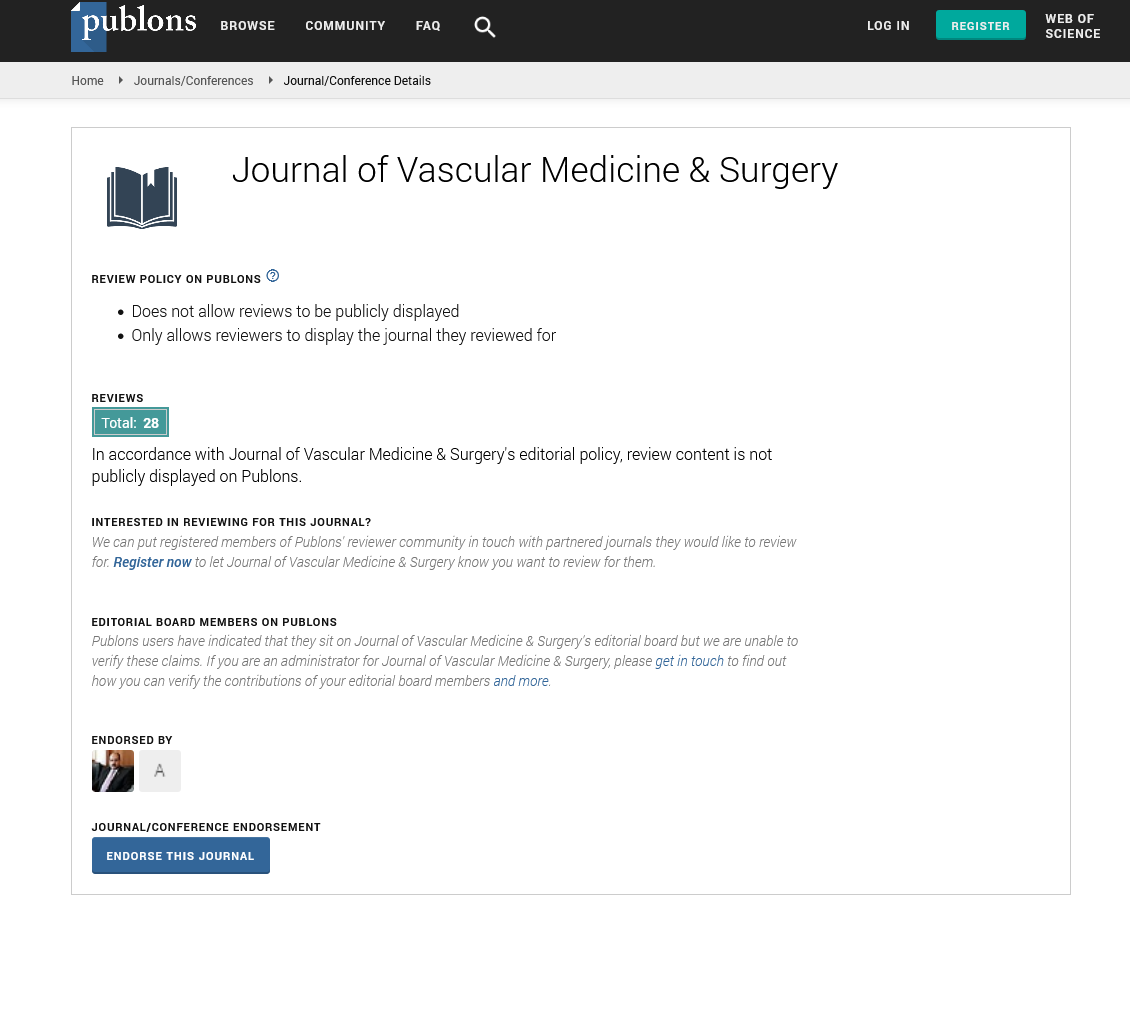Indexed In
- Open J Gate
- Academic Keys
- RefSeek
- Hamdard University
- EBSCO A-Z
- OCLC- WorldCat
- Publons
- Euro Pub
- Google Scholar
- SHERPA ROMEO
Useful Links
Share This Page
Journal Flyer

Open Access Journals
- Agri and Aquaculture
- Biochemistry
- Bioinformatics & Systems Biology
- Business & Management
- Chemistry
- Clinical Sciences
- Engineering
- Food & Nutrition
- General Science
- Genetics & Molecular Biology
- Immunology & Microbiology
- Medical Sciences
- Neuroscience & Psychology
- Nursing & Health Care
- Pharmaceutical Sciences
Commentary Article - (2024) Volume 0, Issue 0
Myocardial Infarction: Diagnosis and Preventing Heart Attacks
Yong Jang*Received: 25-Nov-2024, Manuscript No. JVMS-24-27731; Editor assigned: 27-Nov-2024, Pre QC No. JVMS-24-27731 (PQ); Reviewed: 11-Dec-2024, QC No. JVMS-24-27731; Revised: 18-Dec-2024, Manuscript No. JVMS-24-27731 (R); Published: 27-Dec-2024, DOI: 10.35248/2329-6925.24.S25.564
Description
Myocardial Infarction (MI), also referred to as a cardiac arrest, occurs when blood flow to an area of the heart fails to flow out, causing damage or death of the heart muscle. This disorder is an important factor of mortality and morbidity around the world.
Causes of myocardial infarction
The major cause of myocardial infarction is an inflammation in the coronary arteries, which supply oxygenated blood to the heart muscle. Important contributors include.
Atherosclerosis: Atherosclerosis is the most common cause of myocardial infarctions. It involves the buildup of fatty deposits (plaques) on the arterial walls. These plaques can fracture, establishing a blood clot that blocks the artery.
Coronary artery muscle spasms: In some cases, acute muscle spasms of the coronary artery can decrease blood flow to the heart. This condition may occur due to smoking, drug use (e.g., cocaine) or exposure to extreme stress.
Embolism: A blood clot or other material that travels through the bloodstream and places in a coronary artery.
Coronary artery dissection: A tear in the artery wall, which can lead to obstruction of blood flow.
Low oxygen supply: Conditions such as severe anemia or hypoxia can reduce oxygen delivery to the heart.
Risk factors of myocardial infarction
Several factors increase the probability of experiencing a myocardial infarction. These include.
Lifestyle factors: Smoking, poor diet, lack of physical activity and excessive alcohol consumption.
Chronic conditions: Hypertension, diabetes, obesity and hyperlipidemia.
Age and gender: The risk increases with age and men are generally at higher risk until women experience menopausal.
Family history: A family history of heart disease enhances factors that increase risk.
Stress: Chronic stress contributes to high blood pressure and other cardiovascular issues.
Symptoms of myocardial infarction
The symptoms of myocardial infarction can vary in severity and presentation, but common signs include.
Chest pain or discomfort: A sensation of pressure, tightness or pain in the chest, frequently described as a "painful" feeling. Pain may occur to the jaw, neck, shoulder, arm or spine.
Complications of myocardial infarction
Shortness of breathing: Breathing is difficult, particularly during intense physical activity.
Other symptoms: Nausea, vomiting or indigestion-like discomfort. Sweating, dizziness or lightheadedness.
Silent myocardial infarction: In some cases, myocardial infarction occurs without any identified symptoms. This is more common in individuals with diabetes.
Diagnosis of myocardial infarction
A timely diagnosis is essential for effective therapy and preventing heart damage. Diagnostic methods include.
Clinical history and physical examination: A healthcare provider will assess the patient's symptoms, medical history and risk factors.
Electrocardiogram (ECG): An ECG measures the heart's electrical activity, identifying abnormalities that indicate myocardial infarction.
Imaging studies: Evaluates heart size and includes additional causes of chest pain.
Echocardiography: Uses ultrasound to visualize heart function and detect abnormalities.
Coronary angiography: Identifies a difficulty in the coronary arteries.
Despite immediate treatment, myocardial infarction can result in significant consequences, including: The heart’s pumping ability is weakened due to damaged muscle. Irregular heart rhythms that can be life-threatening. A condition that occurs when the heart fails to circulate enough blood to supply the requirements of the body. Inflammation of the chamber around the heart. The heart stops pumping blood abruptly, requiring emergency treatment.
Prevention of myocardial infarction
Preventive measures focus on managing risk factors and developing a healthy lifestyle. Techniques include: Consuming a diet rich in fruits, vegetables, whole grains and lean proteins. Decreasing the consumption of saturated fat, trans fat and sugars that are added. Reduced tobacco consumption significantly decreases the risk of heart disease. Maintaining a healthy weight increases the possibility of hypertension, diabetes and high cholesterol. Monitoring blood pressure, cholesterol and blood sugar levels helps to detect and manage risks early.
Citation: Jang Y (2024). Myocardial Infarction: Diagnosis and Preventing Heart Attacks. J Vasc Surg. S25:564.
Copyright: © 2024 Jang Y. This is an open access article distributed under the terms of the Creative Commons Attribution License, which permits unrestricted use, distribution and reproduction in any medium, provided the original author and source are credited.

